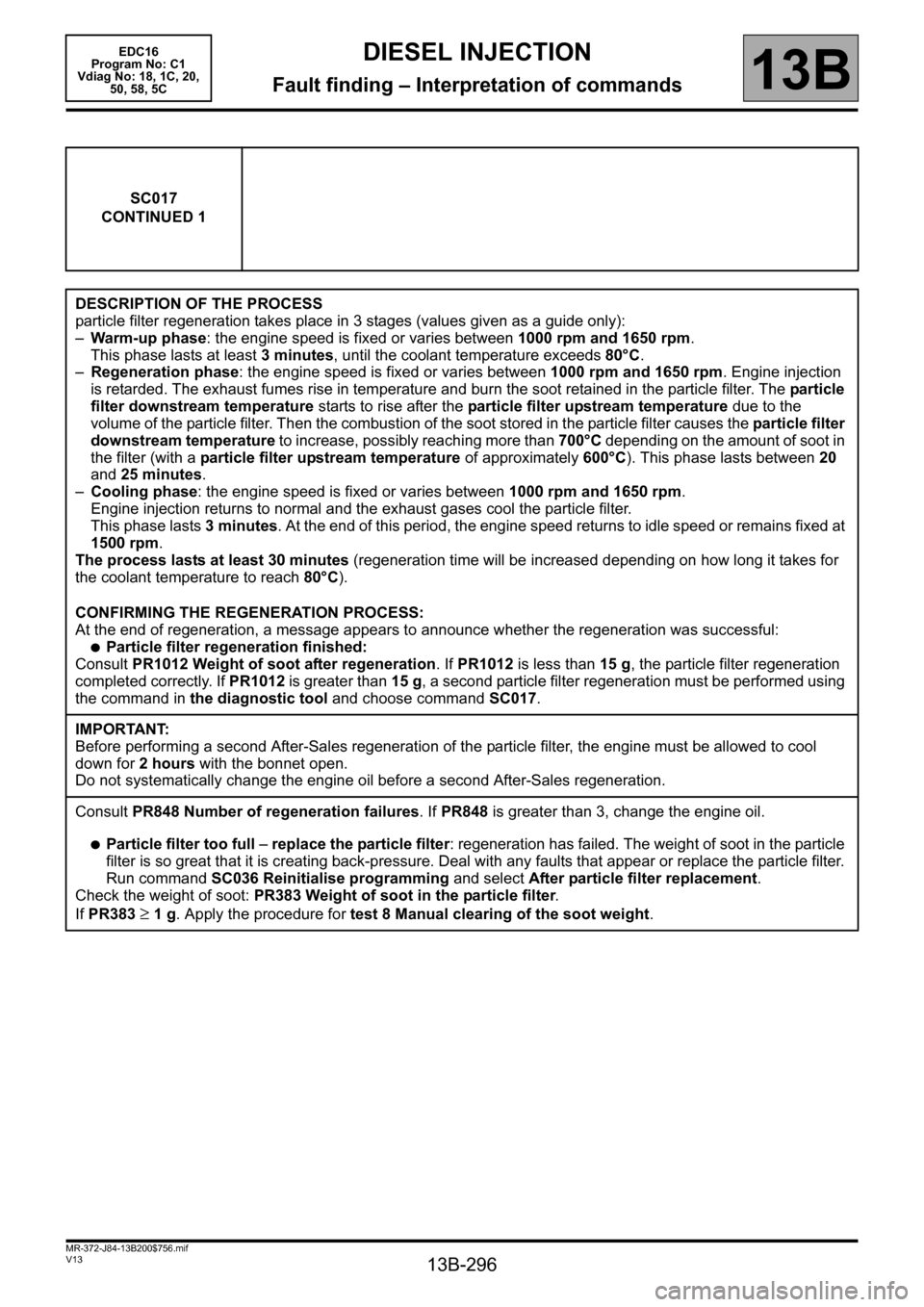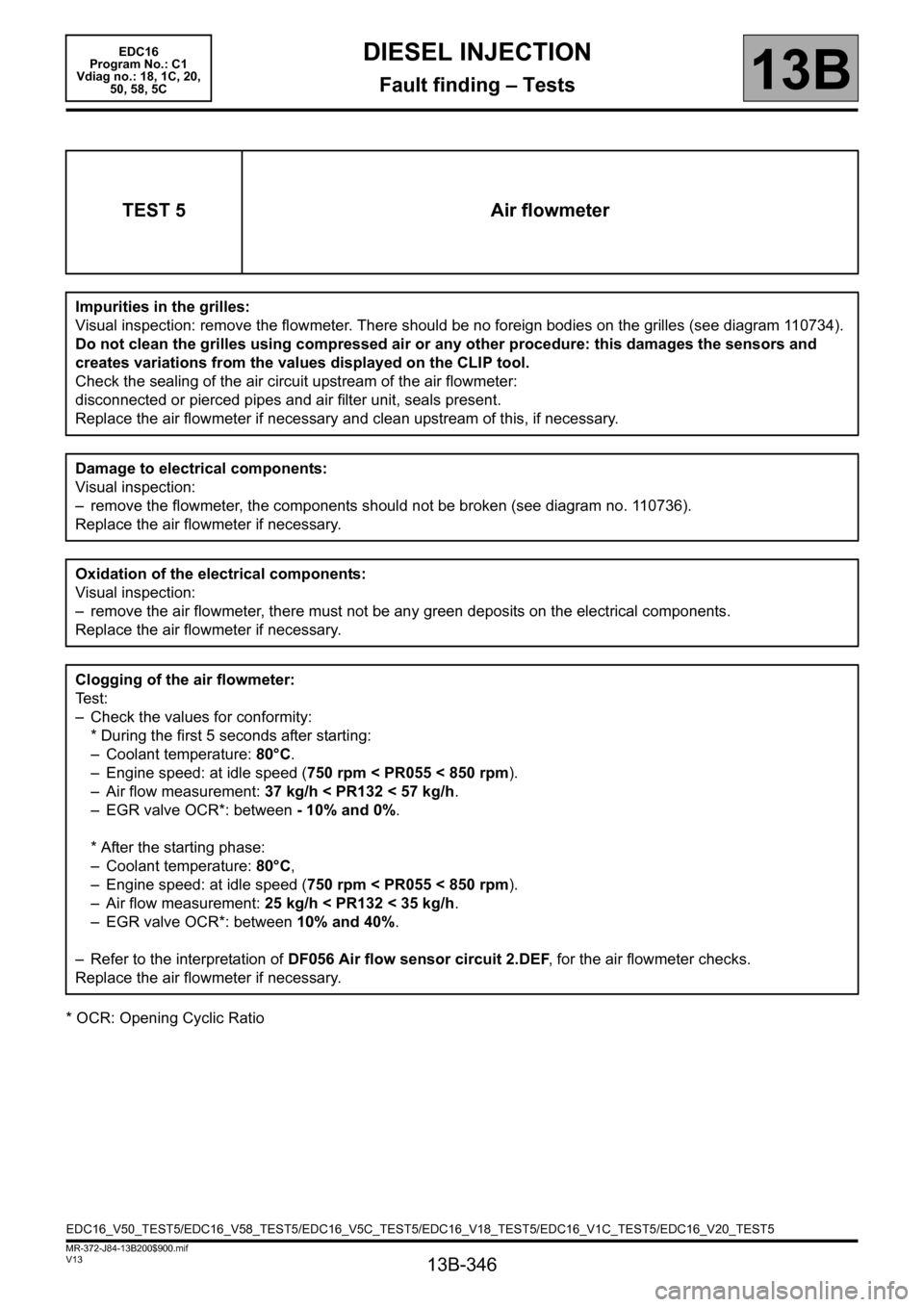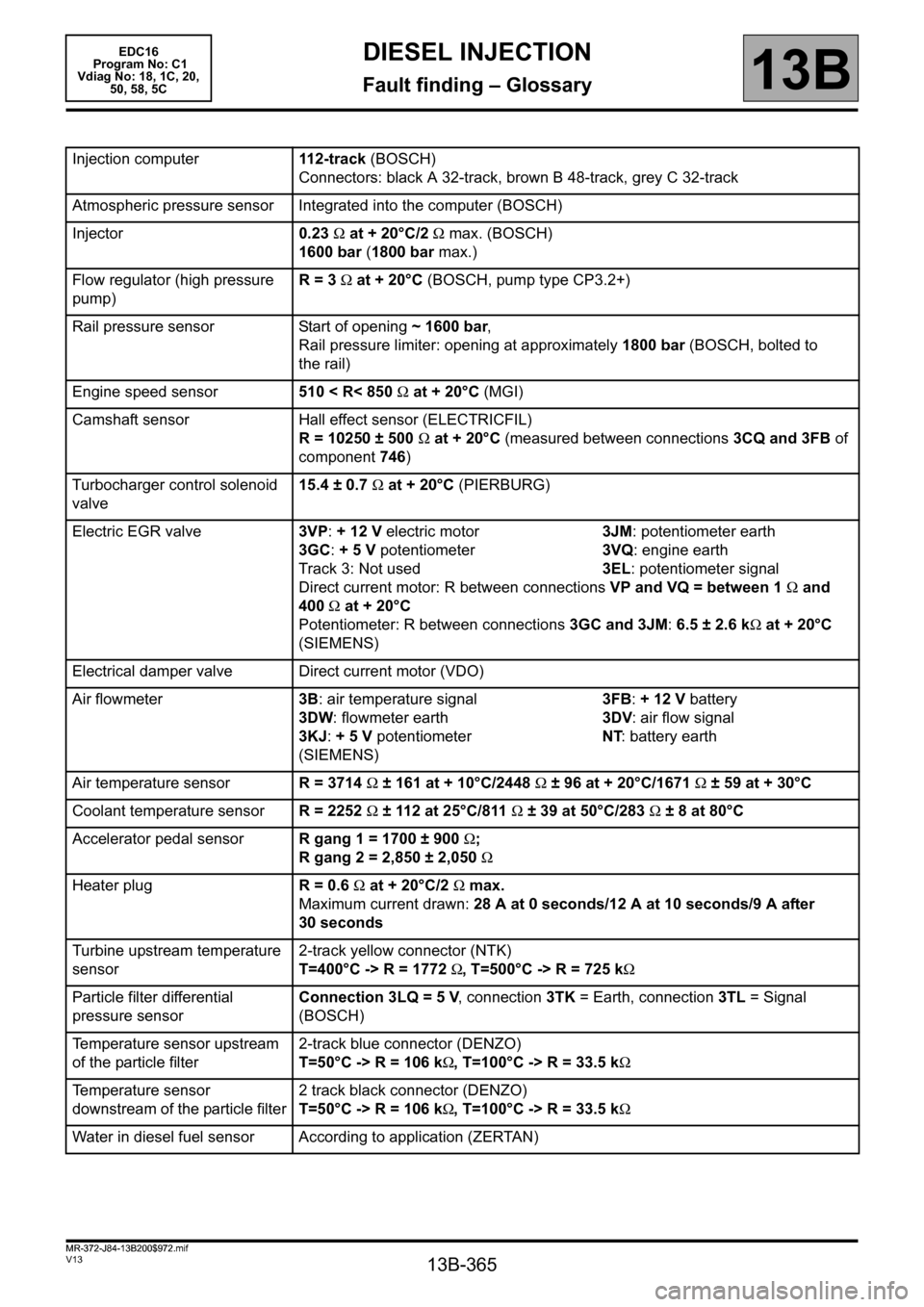2011 RENAULT SCENIC engine coolant
[x] Cancel search: engine coolantPage 296 of 365

13B-296
MR-372-J84-13B200$756.mif
V13
DIESEL INJECTION
Fault finding – Interpretation of commands
EDC16
Program No: C1
Vdiag No: 18, 1C, 20,
50, 58, 5C
13B
SC017
CONTINUED 1
DESCRIPTION OF THE PROCESS
particle filter regeneration takes place in 3 stages (values given as a guide only):
–Warm-up phase: the engine speed is fixed or varies between 1000 rpm and 1650 rpm.
This phase lasts at least 3 minutes, until the coolant temperature exceeds 80°C.
–Regeneration phase: the engine speed is fixed or varies between 1000 rpm and 1650 rpm. Engine injection
is retarded. The exhaust fumes rise in temperature and burn the soot retained in the particle filter. The particle
filter downstream temperature starts to rise after the particle filter upstream temperature due to the
volume of the particle filter. Then the combustion of the soot stored in the particle filter causes the particle filter
downstream temperature to increase, possibly reaching more than 700°C depending on the amount of soot in
the filter (with a particle filter upstream temperature of approximately 600°C). This phase lasts between 20
and 25 minutes.
–Cooling phase: the engine speed is fixed or varies between 1000 rpm and 1650 rpm.
Engine injection returns to normal and the exhaust gases cool the particle filter.
This phase lasts 3 minutes. At the end of this period, the engine speed returns to idle speed or remains fixed at
1500 rpm.
The process lasts at least 30 minutes (regeneration time will be increased depending on how long it takes for
the coolant temperature to reach 80°C).
CONFIRMING THE REGENERATION PROCESS:
At the end of regeneration, a message appears to announce whether the regeneration was successful:
●Particle filter regeneration finished:
Consult PR1012 Weight of soot after regeneration. If PR1012 is less than 15 g, the particle filter regeneration
completed correctly. If PR1012 is greater than 15 g, a second particle filter regeneration must be performed using
the command in the diagnostic tool and choose command SC017.
IMPORTANT:
Before performing a second After-Sales regeneration of the particle filter, the engine must be allowed to cool
down for 2 hours with the bonnet open.
Do not systematically change the engine oil before a second After-Sales regeneration.
Consult PR848 Number of regeneration failures. If PR848 is greater than 3, change the engine oil.
●Particle filter too full – replace the particle filter: regeneration has failed. The weight of soot in the particle
filter is so great that it is creating back-pressure. Deal with any faults that appear or replace the particle filter.
Run command SC036 Reinitialise programming and select After particle filter replacement.
Check the weight of soot: PR383 Weight of soot in the particle filter.
If PR383
≥ 1 g. Apply the procedure for test 8 Manual clearing of the soot weight.
Page 319 of 365

13B-319
MR-372-J84-13B200$828.mif
V13
EDC16
Program No.: C1
Vdiag no.: 18, 1C, 20,
50, 58, 5CDIESEL INJECTION
Fault finding – Fault Finding Chart13B
ALP 2 Starting difficult (or impossible)
NOTESBefore dealing with this customer complaint, check that there are no faults, and
the conformity (or otherwise) of the parameters and statuses using the
diagnostic tool.
If the customer complaint is not eliminated, perform the following checks.
Is it difficult or impossible to start the engine?
PART A:
Check the engine earths.
Ensure that the engine speed reaches 250 rpm with the starter motor, as displayed on the parameter screen (PR055
Engine speed).
If the engine speed is less than 250 rpm, refer to Technical Note 6014A, Checking the charging circuit.
If the engine speed shown on CLIP is zero and the engine is running, check the resistance of the engine speed
sensor between connections 3BG and 3BL of component 149:
Replace the sensor if its resistance is not 510 Ω < X < 850 Ω at 20°C
Check the continuity of the following connections:
– connection codes 3BG and 3BL between components 120 and 149.
Check the conformity of the engine earths (oxidation, tightness, etc.).
Check the mounting, the gap (if necessary refer to the information in the workshop repair manual for the vehicle) and
the condition of the sensor (overheating).
Replace if necessary.
Check the synchronisation of the camshaft sensors and the engine speed sensors with the display of ET238
Synchronisation.
If synchronisation is not active, refer to the checks described in DF195 Camshaft/engine speed consistency.
check the fuel circuit sealing.
If the fault is still present, see DF053 Rail pressure regulation function 2.DEF, step 4.
Check that the heater plugs are actuated using the AC001 Preheating unit command.
Check the sealing and condition of the inlet circuit: run Test 4 Turbocharged air inlet circuit check and follow the
associated fault finding procedure.
Check that there are no foreign bodies on the flowmeter grille: run Test 5 Air flowmeter and follow the associated
fault finding procedure.
Check the position of the exhaust gas recirculation valve.
Check that the exhaust is not blocked: run Test 1 Exhaust pipe check and follow the associated fault finding
procedure.
Check the consistency of the signal from the engine coolant temperature sensor.
Check the operation of the pressure regulator (see AC011 Rail pressure regulator).
Check the operation of the injectors (excessive return leak, clogging, seizing): run Test 9 Poor injector operation.
Check the engine timing (and the position of the high pressure pump sprocket).
Check the balance of the compressions, according to the power consumption during the starting phase
(Compression test menu on the CLIP Technic tool or using a compression gauge)
after the operation, clear the faults caused by disconnecting the regulator and the heater plugs.
End of part AImpossible
AFTER REPAIRCarry out a road test followed by a complete check with the diagnostic tool.
EDC16_V50_ALP2/EDC16_V58_ALP2/EDC16_V5C_ALP2/EDC16_V18_ALP2/EDC16_V1C_ALP2/EDC16_V20_ALP2
Page 323 of 365

13B-323
MR-372-J84-13B200$828.mif
V13
DIESEL INJECTION
Fault finding – Fault Finding Chart
EDC16
Program No.: C1
Vdiag no.: 18, 1C, 20,
50, 58, 5C
13B
ALP 4
CONTINUED
Check the injector operation: run test 9.
If the fault is still present
Check the conformity of the accelerator pedal position sensor, the brake pedal sensor, the atmospheric pressure
sensor, the exhaust gas recirculation valve and the damper valve.
Check the consistency of the signal: of the air flowmeter, of the engine coolant temperature sensor, of the fuel
temperature sensor and of the engine speed.
Check the connections, continuity and absence of interference resistance on the air flow sensor (run DF056 Air
flow sensor circuit, 2.DEF), the engine coolant temperature sensor (run DF001 Coolant circuit, 1.DEF), and
the engine speed (run DF195 Engine speed / camshaft sensor consistency, 2.DEF).
Check:
– That the diesel filter is not clogged (for the test, see DF053 Rail pressure regulation function 2.def).
– That there are no leaks on the high and low pressure diesel circuits, run Test 4 Turbocharged air inlet circuit
check.
– That the oil vapour rebreathing system is connected.
– The flow regulator (jammed / seized), apply the interpretation of command AC011 Rail pressure regulator.
– Check the timing setting (and the position of the high pressure pump pinion)
– Check the engine compressions (cylinder compression balance with the Compression test function on the
CLIP Technic tool).
– Measure the engine compressions with the special tool
– If the fault is still present, contact the techline.
AFTER REPAIRCarry out a road test followed by a complete check with the diagnostic tool.
Page 325 of 365

13B-325
MR-372-J84-13B200$828.mif
V13
EDC16
Program No.: C1
Vdiag no.: 18, 1C, 20,
50, 58, 5CDIESEL INJECTION
Fault finding – Fault Finding Chart13B
ALP 6 Fuel system leaks
NOTESBefore dealing with this customer complaint, check that there are no faults, and
the conformity (or otherwise) of the parameters and statuses using the
diagnostic tool.
If the customer complaint is not eliminated, perform the following checks.
IMPORTANT
Please observe the cleanliness guidelines and safety advice.
Procedure for checking for an external leak on the fuel circuit:
Clean away traces of grease with clean thinner and wipe the part or parts concerned with cleaning cloths.
Start the engine and increase the engine coolant temperature to 80°C.
Stop the engine and check for traces of grease on the part or parts concerned.
If this is the case, replace the part or parts concerned.
Bleed the fuel circuit and continue the checks.
Does the priming bulb show traces of grease? (Visual
and tactile inspections)
(If there is a priming bulb)
NO
Does the diesel filter show traces of grease?
(Visual and tactile inspections)
NO
Do the fuel return pipes show traces of grease?
(Visual and tactile inspections)
NO
YESCheck the assembly
of the components
and the condition of
the seal at the union
of the two
components, if the
leak is at the seal.
Replace the part or
the parts concerned.
Bleed the fuel circuit
and continue the
checks.
YES
YES
AFTER REPAIRCarry out a road test followed by a complete check with the diagnostic tool.
EDC16_V50_ALP6/EDC16_V58_ALP6/EDC16_V5C_ALP6/EDC16_V18_ALP6/EDC16_V1C_ALP6/EDC16_V20_ALP6
Page 346 of 365

13B-346
MR-372-J84-13B200$900.mif
V13
DIESEL INJECTION
Fault finding – Tests
EDC16
Program No.: C1
Vdiag no.: 18, 1C, 20,
50, 58, 5C
13B
* OCR: Opening Cyclic Ratio
TEST 5 Air flowmeter
Impurities in the grilles:
Visual inspection: remove the flowmeter. There should be no foreign bodies on the grilles (see diagram 110734).
Do not clean the grilles using compressed air or any other procedure: this damages the sensors and
creates variations from the values displayed on the CLIP tool.
Check the sealing of the air circuit upstream of the air flowmeter:
disconnected or pierced pipes and air filter unit, seals present.
Replace the air flowmeter if necessary and clean upstream of this, if necessary.
Damage to electrical components:
Visual inspection:
– remove the flowmeter, the components should not be broken (see diagram no. 110736).
Replace the air flowmeter if necessary.
Oxidation of the electrical components:
Visual inspection:
– remove the air flowmeter, there must not be any green deposits on the electrical components.
Replace the air flowmeter if necessary.
Clogging of the air flowmeter:
Te s t :
– Check the values for conformity:
* During the first 5 seconds after starting:
– Coolant temperature: 80°C.
– Engine speed: at idle speed (750 rpm < PR055 < 850 rpm).
– Air flow measurement: 37 kg/h < PR132 < 57 kg/h.
– EGR valve OCR*: between - 10% and 0%.
* After the starting phase:
– Coolant temperature: 80°C,
– Engine speed: at idle speed (750 rpm < PR055 < 850 rpm).
– Air flow measurement: 25 kg/h < PR132 < 35 kg/h.
– EGR valve OCR*: between 10% and 40%.
– Refer to the interpretation of DF056 Air flow sensor circuit 2.DEF, for the air flowmeter checks.
Replace the air flowmeter if necessary.
EDC16_V50_TEST5/EDC16_V58_TEST5/EDC16_V5C_TEST5/EDC16_V18_TEST5/EDC16_V1C_TEST5/EDC16_V20_TEST5
Page 348 of 365

13B-348
MR-372-J84-13B200$900.mif
V13
EDC16
Program No.: C1
Vdiag no.: 18, 1C, 20,
50, 58, 5CDIESEL INJECTION
Fault finding – Tests13B
TEST8 Manual clearing of the soot weight
Note: In certain cases, this procedure is to be carried out only after replacement of the particle filter or after an
After-sales regeneration of the particle filter.
– Start the engine.
– Raise the engine coolant temperature.
– Read the coolant temperature with PR064 Coolant temperature until a value greater than 65ºC is obtained.
– Accelerate the engine to 4000 rpm and maintain this speed for 5 minutes.
–After 5 minutes, release the accelerator and stop the engine.
– Switch on the ignition.
– Run command SC036 Reinitialise programming and select After particle filter replacement or After
particle filter regeneration (as appropriate).
– Switch off the ignition and wait for the diagnostic tool message (maximum time 8 minutes): Communication
lost with computer: EDC16C36, check the tool connection and computer power supply.
–Then switch on the ignition again, clear the present or stored faults from the computer memory (operation
to be carried out within 3 minutes of switching on the ignition).
EDC16_V50_TEST8/EDC16_V58_TEST8/EDC16_V5C_TEST8/EDC16_V18_TEST8/EDC16_V1C_TEST8/EDC16_V20_TEST8
Page 365 of 365

13B-365
MR-372-J84-13B200$972.mif
V13
13B
DIESEL INJECTION
Fault finding – Glossary
Injection computer112-track (BOSCH)
Connectors: black A 32-track, brown B 48-track, grey C 32-track
Atmospheric pressure sensor Integrated into the computer (BOSCH)
Injector0.23 Ω at + 20°C/2 Ω max. (BOSCH)
1600 bar (1800 bar max.)
Flow regulator (high pressure
pump)R = 3 Ω at + 20°C (BOSCH, pump type CP3.2+)
Rail pressure sensor Start of opening ~ 1600 bar,
Rail pressure limiter: opening at approximately 1800 bar (BOSCH, bolted to
the rail)
Engine speed sensor510 < R< 850 Ω at + 20°C (MGI)
Camshaft sensor Hall effect sensor (ELECTRICFIL)
R = 10250 ± 500 Ω at + 20°C (measured between connections 3CQ and 3FB of
component 746)
Turbocharger control solenoid
valve15.4 ± 0.7 Ω at + 20°C (PIERBURG)
Electric EGR valve3VP: + 12 V electric motor 3JM: potentiometer earth
3GC: + 5 V potentiometer 3VQ: engine earth
Track 3: Not used 3EL: potentiometer signal
Direct current motor: R between connections VP and VQ = between 1 Ω and
400 Ω at + 20°C
Potentiometer: R between connections 3GC and 3JM: 6.5 ± 2.6 kΩ at + 20°C
(SIEMENS)
Electrical damper valve Direct current motor (VDO)
Air flowmeter3B: air temperature signal 3FB: + 12 V battery
3DW: flowmeter earth 3DV: air flow signal
3KJ: + 5 V potentiometer NT: battery earth
(SIEMENS)
Air temperature sensorR = 3714
Ω ± 161 at + 10°C/2448 Ω ± 96 at + 20°C/1671 Ω ± 59 at + 30°C
Coolant temperature sensorR = 2252 Ω ± 112 at 25°C/811 Ω ± 39 at 50°C/283 Ω ± 8 at 80°C
Accelerator pedal sensorR gang 1 = 1700 ± 900 Ω;
R gang 2 = 2,850 ± 2,050Ω
Heater plugR = 0.6 Ω at + 20°C/2 Ω max.
Maximum current drawn: 28 A at 0 seconds/12 A at 10 seconds/9 A after
30 seconds
Turbine upstream temperature
sensor2-track yellow connector (NTK)
T=400°C -> R = 1772 Ω, T=500°C -> R = 725 kΩ
Particle filter differential
pressure sensorConnection 3LQ = 5 V, connection 3TK = Earth, connection 3TL = Signal
(BOSCH)
Temperature sensor upstream
of the particle filter2-track blue connector (DENZO)
T=50°C -> R = 106 kΩ, T=100°C -> R = 33.5 kΩ
Temperature sensor
downstream of the particle filter2 track black connector (DENZO)
T=50°C -> R = 106 kΩ, T=100°C -> R = 33.5 kΩ
Water in diesel fuel sensor According to application (ZERTAN)
MR-372-J84-13B200$972.mif
EDC16
Program No: C1
Vdiag No: 18, 1C, 20,
50, 58, 5C